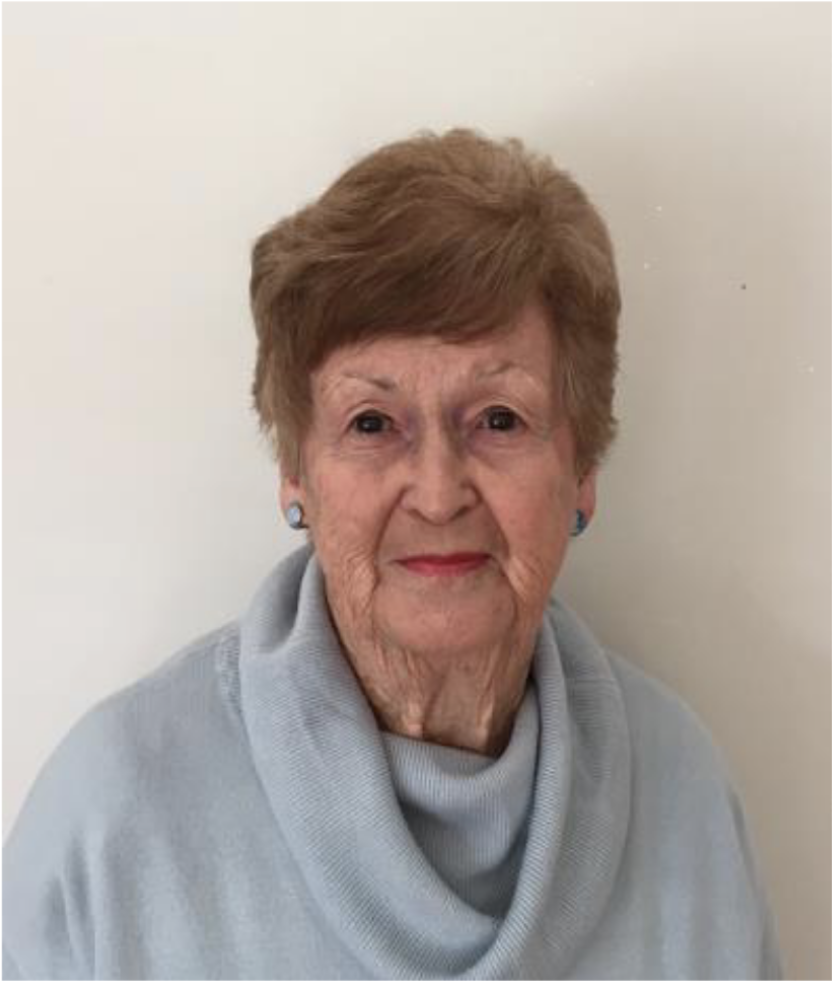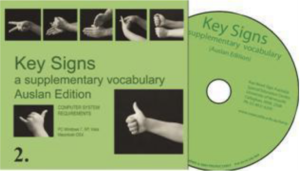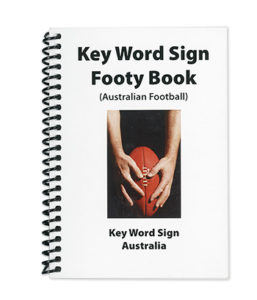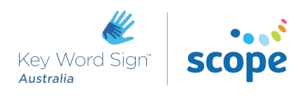
It’s still the family joke that I produced a book on footy!
How did I make the transition from primary school teaching to helping to produce a number of books and CD-Roms for Key Word Sign Australia? I trained at Wagga Wagga Teacher’s College 1950-51, taught for 3 years at an outer Sydney suburb, had a year at Wagga Demonstration School, then back to Sydney where I married and had three daughters. My husband was transferred to Melbourne and we established a home in a new city.
When the girls were at school I decided to upgrade my qualifications to three year trained status in the Victorian system. Following graduation I obtained a position in a Special Education setting and became hooked on the diversity of programs and the colleagues who were so committed to education of intellectually disabled children. After 3 years in this setting I applied to complete a Graduate Diploma in Special Education at Deakin University. I was granted part time study leave and part time work at a Special School. Because I was working at the school part time, I was given the role of Speech and Language teacher. One of the grades had 6 out of the 8 children who were non-verbal or who had speech which could not be understood. “Help!” – what to do? With a Speech Pathologist visiting only one week each term, my challenge as the Speech and Language teacher was to develop programs to cater for the school’s 120 students.
I decided to complete a 4 day Makaton course, a language program using manual signs and pictographs which had been developed in the UK for people with communication difficulties. After attending this, I introduced Makaton vocabulary into the school and to the families. I was indeed fortunate that I had the support of the administration and all the teachers. It worked! I held sessions and activities in the classrooms so the teachers and the verbal students could learn the signs and communicate with their hearing but non-verbal peers. Soon I was running workshops for parents and teachers from other schools.
Several submissions to philanthropic organisations were successful in obtaining computers and electronic speech aids to assist communication in addition to signing. Again, as speech pathology services were minimal, I had to program the electronic aids. However the parents were fantastic as they could see such a change in their children.
In 1997 I retired from the Victorian Education Department but informed the Makaton Victoria committee, of which I was a member, that I would help out if required. This was the beginning of another huge phase in my life and 22 years later, continues!
I have been involved with the production of a number of resources in my time on the committee. In 2000 Makaton Australia produced the The Makaton Vocabulary with Australian signs. After consultation with North Rocks Press and Trevor Johnston to obtain permission to use the line drawings from the book Auslan Dictionary: A Dictionary of the Sign Language of the Australian Deaf Community, I joined forces with Dr Judith Cowley from Newcastle University and Aileen Ryan, an Auslan interpreter and mother of a disabled child to produce a new Australian book. We consulted with Speech Pathologists, Special Education Teachers and the Deaf Community around Australia to publish, through Newcastle University, The Makaton Vocabulary – Auslan Edition. Finances were tight with the organisation to Peter, my husband, produced the photographs and the cover of this first book.
Aileen Ryan had developed an extension vocabulary to the basic Makaton vocabulary. She again accessed North Rocks Press line drawings and after consultation around Australia, Cathy Basterfield, a Speech Pathologist then from Scope Victoria, and I wrote the descriptions to accompany the signs for Key Signs: a Supplement to the Makaton Vocabulary – Auslan Edition.
 Next challenge was to make a CD-Rom which would demonstrate how to make the manual signs and how to use them in conversation. In collaboration with Latrobe University Media Unit, a script was developed and filming was completed. The first CD-Rom to accompany the Makaton book showed video clips of over 400 signs; a word search facility; repeat view options of all video clips; finger spelling alphabet; sample signing scenarios; stages 1- 9 of the Australian Makaton Vocabulary and picture based multiple choice test questions. It was indeed an interesting experience watching the film crew and monitoring whether the speech pathologists were modelling the signs correctly and following the video cues. There were some interesting bloopers!
Next challenge was to make a CD-Rom which would demonstrate how to make the manual signs and how to use them in conversation. In collaboration with Latrobe University Media Unit, a script was developed and filming was completed. The first CD-Rom to accompany the Makaton book showed video clips of over 400 signs; a word search facility; repeat view options of all video clips; finger spelling alphabet; sample signing scenarios; stages 1- 9 of the Australian Makaton Vocabulary and picture based multiple choice test questions. It was indeed an interesting experience watching the film crew and monitoring whether the speech pathologists were modelling the signs correctly and following the video cues. There were some interesting bloopers!
A CD-Rom was later made to accompany the Key Signs vocabulary. Just before this CD was put to bed it was decided to sever the licence agreement with Makaton UK and to develop an Australian vocabulary for Key Word Sign Australia. So some hurried rewriting and re-filming of certain sections had to be done to eliminate the mention of Makaton as it is a registered trademark.
 When completing my Graduate Diploma of Special Education, the Advocacy unit I studied had been very practical and each student was matched with an intellectually disabled adult to enable them to participate in community programs. After completing my course, my family and I continued this association with the young man assigned to me through Citizen Advocacy Victoria. He was an avid AFL supporter like many residents in Community Residential homes. So in 2009 I decided I would put together a Footy Book with signs for the AFL teams and associated words. Permission to use the club logos had to be sought from the AFL and the Deaf community consulted about signs that were used. After many hours of consulting with a graphic designer for the line drawings to represent the signs, a grand launch of the Footy Book took place in 2010 at Etihad (now Marvel) Stadium and was unveiled by Simon Crean, the then Minister for Social Inclusion. Over 120 children and adults with disabilities attended and most joined in the footy clinics which were held to accompany the launch. Representatives from the Marngrook Footy TV Show and the Football Integration Development Association demonstrated techniques of kicking and marking. Physically disabled students sang and signed “Up there Cazaly”. The book and launch received mention in the Footy Record as well as appearing on Channel 31. Quite an event! It’s still the family joke that I produced a book on footy! The NRL book is still in the pipeline!
When completing my Graduate Diploma of Special Education, the Advocacy unit I studied had been very practical and each student was matched with an intellectually disabled adult to enable them to participate in community programs. After completing my course, my family and I continued this association with the young man assigned to me through Citizen Advocacy Victoria. He was an avid AFL supporter like many residents in Community Residential homes. So in 2009 I decided I would put together a Footy Book with signs for the AFL teams and associated words. Permission to use the club logos had to be sought from the AFL and the Deaf community consulted about signs that were used. After many hours of consulting with a graphic designer for the line drawings to represent the signs, a grand launch of the Footy Book took place in 2010 at Etihad (now Marvel) Stadium and was unveiled by Simon Crean, the then Minister for Social Inclusion. Over 120 children and adults with disabilities attended and most joined in the footy clinics which were held to accompany the launch. Representatives from the Marngrook Footy TV Show and the Football Integration Development Association demonstrated techniques of kicking and marking. Physically disabled students sang and signed “Up there Cazaly”. The book and launch received mention in the Footy Record as well as appearing on Channel 31. Quite an event! It’s still the family joke that I produced a book on footy! The NRL book is still in the pipeline!
Key Word Sign Victoria then began the process of producing the line drawings for 600+ manual signs for the Key Word Sign App. The vocabulary was chosen based on research and word frequency use and it was a big task bringing it all together with many hours of studying the graphic designer’s drawings for accuracy, ensuring the descriptions for the signs were clear and concise and proof reading. Key Word Sign Australia produced the app, which was launched at the end of 2016.
Getting Started with Key Word Sign is the handbook for introducing Key Word Sign into the communication environment. It contains about 100 line drawings and descriptions of gestures and manual signs, and is the “starter set” to use with children and adults who have communication disabilities.
I continue to assist speech pathologists in coordinating training and signing update workshops so the Presenters around Victoria and Australia can remain cognisant of developments in alternative and augmentative means of communication. It is exciting to be part of a highly professional and dedicated team (of much younger members!) and to know that the work will be of great value to many individuals and families around Australia.
In 2019 Ella will have been an active voluntary committee member with Key Word Sign Victoria for 22 years.
At the AGOSCI Conference in 2019, Ella received the Distinguished Services Award for her long contribution to Key Word Sign.

